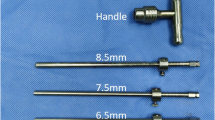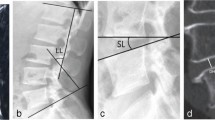Abstract
Objectives
Redundant Nerve Root (RNR) is a tortuous and elongated radiological appearance of cauda equina on Magnetic Resonance Imaging (MRI) in Lumbar Spinal Canal Stenosis (LSCS) patients. This study evaluated preoperative spinal morphometry associated with the development of RNR.
Methods
The retrospective cohort was conducted at The Aga Khan University Hospital, and included patients undergoing decompressive spinal surgery secondary to degenerative LSCS in 2015. The patients were divided into two groups with respect to the presence of preoperative RNR. Spinal morphometry was defined by several radiological parameters, including areas of dural sac (DSA), spinal canal, spinal foramen, facets, and spinal joints, and bilateral angles based on vertebral anatomy.
Results
A total of 55 patients were enrolled with a mean age of 57.1 years, in which 22 (40%) expressed RNR in their MRI. The RNR group had significantly lower mean DSA (59.64 vs 84.01 mm2; p = 0.028), bilateral posterior facet angle (Right: 33.84 vs 46.21, p = 0.004; Left: 36.43 vs 43.80, p = 0.039) and higher bilateral anterior facet angles (Right: 54.85 vs 44.57, p = 0.026; Left: 55.27 vs 46.36, p = 0.050) compared to the non-RNR group. The other bidimensional and angular parameters did not observe any statistical difference between the two groups.
Conclusion
RNR was associated with a higher degree of stenosis in patients with LSCS. Bilateral anterior and posterior facets angles contribute to its development, indicating particular spinal morphology to be vulnerable to the stenotic disease.





Similar content being viewed by others
References
Cressman MR, Pawl RP (1968) Serpentine myelographic defect caused by a redundant nerve root. Case report. J Neurosurg 28(4):391–393
Verbiest H (1954) A radicular syndrome from developmental narrowing of the lumbar vertebral canal. J Bone Joint Surg Br 36-b(2):230–7
Hakan T et al (2008) The redundant nerve root syndrome of the cauda equina. Turk Neurosurg 18(2):204–206
Ozturk AK, Gokaslan ZL (2014) Clinical significance of redundant nerve roots of the cauda equina. World Neurosurg 82(6):e717–e718
Rengachary SS et al (1980) Suggested pathological basis of “redundant nerve root syndrome” of the cauda equina. Neurosurgery 7(4):400–411
Suzuki K et al (1989) Redundant nerve roots of the cauda equina: clinical aspects and consideration of pathogenesis. Neurosurgery 24(4):521–528
Suzuki K et al (1992) Redundant nerve roots of the cauda equina caused by lumbar spinal canal stenosis. Spine (Phila Pa 1976) 17(11):1337–42
Cong L et al (2017) A meta-analysis on the clinical significance of redundant nerve roots in symptomatic lumbar spinal stenosis. World Neurosurg 105:95–101
Chen J et al (2016) Post-surgical functional recovery, lumbar lordosis, and range of motion associated with MR-detectable redundant nerve roots in lumbar spinal stenosis. Clin Neurol Neurosurg 140:79–84
Hur JW et al (2012) Radiological significance of ligamentum flavum hypertrophy in the occurrence of redundant nerve roots of central lumbar spinal stenosis. J Korean Neurosurg Soc 52(3):215–220
Min JH, Jang JS, Lee SH (2008) Clinical significance of redundant nerve roots of the cauda equina in lumbar spinal stenosis. Clin Neurol Neurosurg 110(1):14–18
Ono A et al (2007) Clinical significance of the redundant nerve roots of the cauda equina documented on magnetic resonance imaging. J Neurosurg Spine 7(1):27–32
Nathani KR et al (2021) Role of redundant nerve roots in clinical manifestations of lumbar spine stenosis. Surg Neurol Int 12:218
Poureisa M et al (2015) Redundant nerve roots of the cauda equina in lumbar spinal canal stenosis, an MR study on 500 cases. Eur Spine J 24(10):2315–2320
Nogueira-Barbosa MH et al (2012) Redundant nerve roots of the cauda equina: review of the literature. Radiol Bras 45(3):155–159
Xu J, Hu Y (2021) Clinical features and efficacy analysis of redundant nerve roots. Front Surg 8:628928
Yokoyama K et al (2014) Clinical significance of postoperative changes in redundant nerve roots after decompressive laminectomy for lumbar spinal canal stenosis. World Neurosurg 82(6):e825–e830
Gökçe E, Beyhan M (2021) Magnetic resonance imaging findings of redundant nerve roots of the cauda equina. World J Radiol 13(1):29–39
Tsuji H et al (1985) Redundant nerve roots in patients with degenerative lumbar spinal stenosis. Spine (Phila Pa 1976) 10(1):72–82
Goldberg JL et al (2022) Clinical significance of redundant nerve roots in patients with lumbar stenosis undergoing minimally invasive tubular decompression. World Neurosurg. https://doi.org/10.1016/j.wneu.2022.05.061
Savarese LG et al (2014) Cauda equina redundant nerve roots are associated to the degree of spinal stenosis and to spondylolisthesis. Arq Neuropsiquiatr 72(10):782–787
Funding
This research did not receive any specific grant from funding agencies in the public, commercial, or not-for-profit sectors.
Author information
Authors and Affiliations
Corresponding author
Ethics declarations
Conflict of interest
The authors declare that they have no conflict of interest.
Ethical approval and Informed consent
The study was performed following approval of the institutional ethics review committee and in accordance with the 1964 Helsinki declaration and its later amendments or comparable ethical standards. Individual patient consent was not required as no identifying information was presented in the study.
Additional information
Publisher's Note
Springer Nature remains neutral with regard to jurisdictional claims in published maps and institutional affiliations.
Rights and permissions
Springer Nature or its licensor holds exclusive rights to this article under a publishing agreement with the author(s) or other rightsholder(s); author self-archiving of the accepted manuscript version of this article is solely governed by the terms of such publishing agreement and applicable law.
About this article
Cite this article
Nathani, K.R., Barakzai, M.D., Rai, H.H. et al. Redundant nerve roots indicate higher degree of stenosis in lumbar spine stenotic patients. Acta Neurol Belg 123, 1781–1787 (2023). https://doi.org/10.1007/s13760-022-02040-w
Received:
Accepted:
Published:
Issue Date:
DOI: https://doi.org/10.1007/s13760-022-02040-w




